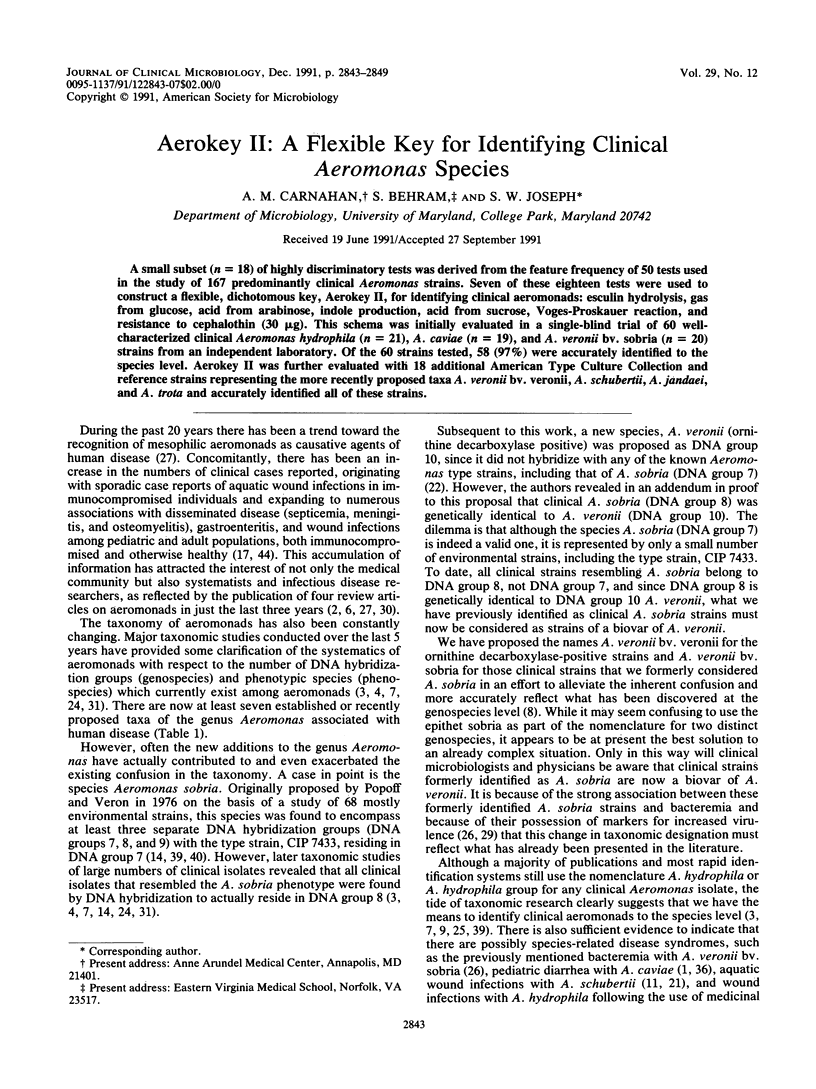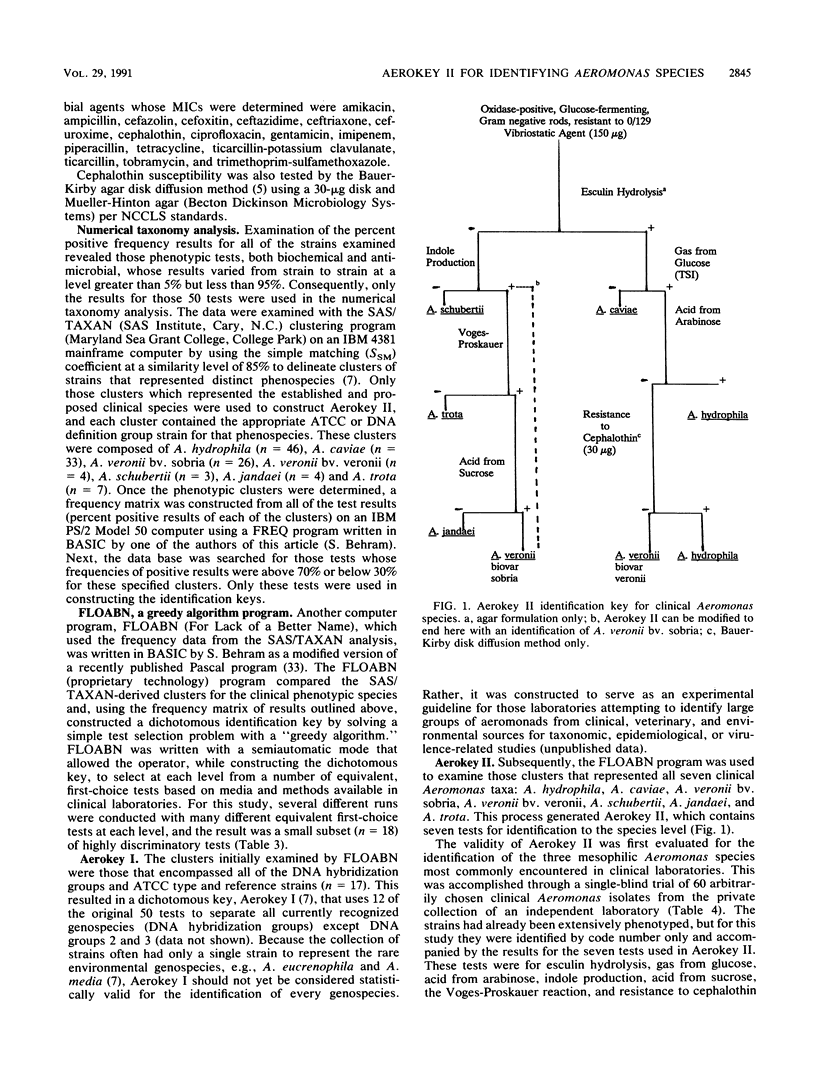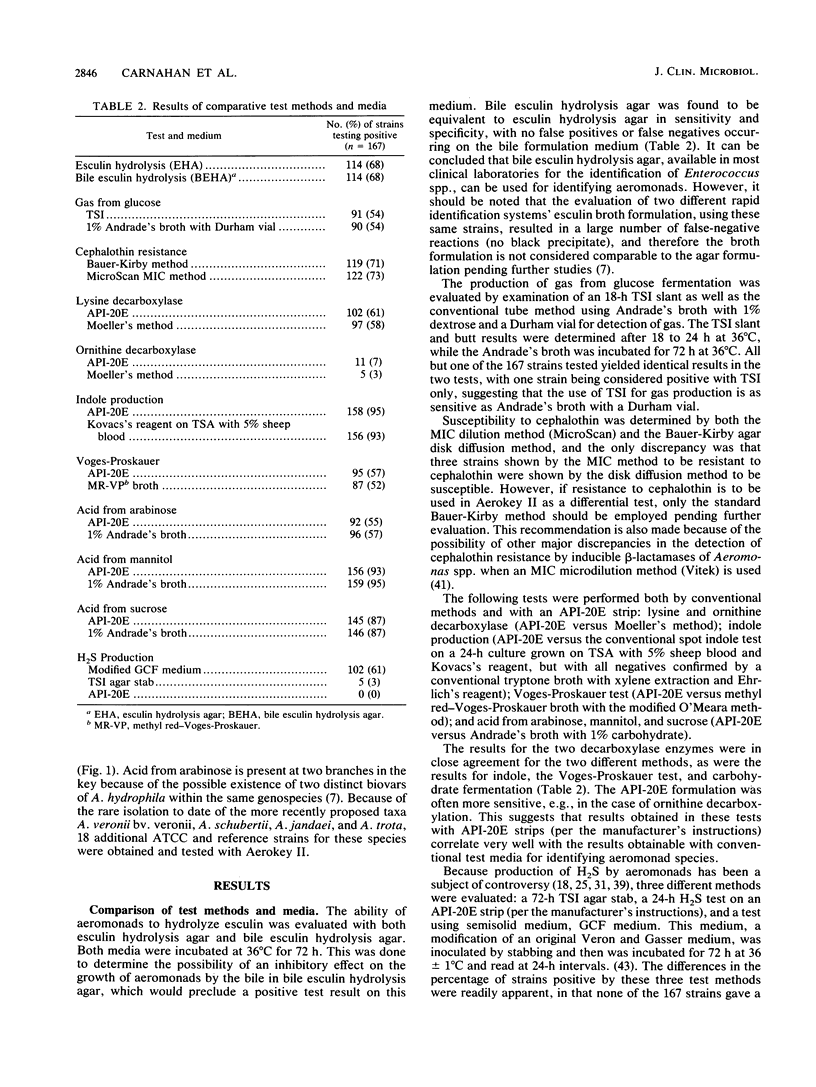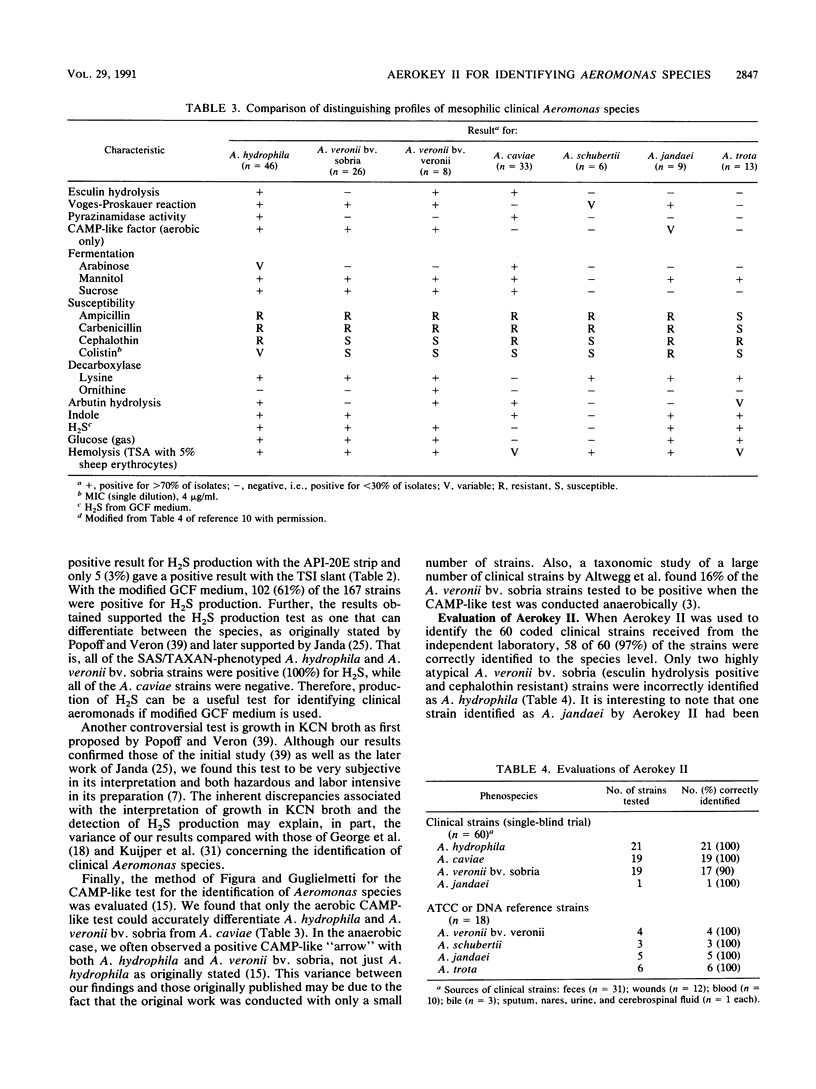Abstract
A small subset (n = 18) of highly discriminatory tests was derived from the feature frequency of 50 tests used in the study of 167 predominantly clinical Aeromonas strains. Seven of these eighteen tests were used to construct a flexible, dichotomous key, Aerokey II, for identifying clinical aerontonads: esculin hydrolysis, gas from glucose, acid from arabinose, indole production, acid from sucrose, Voges-Proskauer reaction, and resistance to cephalothin (30 micrograms). This schema was initially evaluated in a single-blind trial of 60 well-characterized clinical Aeromonas hydrophila (n = 21), A. caviae (n = 19), and A. veronii bv. sobria (n = 20) strains from an independent laboratory. Of the 60 strains tested, 58 (97%) were accurately identified to the species level. Aerokey II was further evaluated with 18 additional American Type Culture Collection and reference strains representing the more recently proposed taxa A. veronii bv. veronii, A. schubertii, A. jandaei, and A. trota and accurately identified all of these strains.
Full text
PDF






Selected References
These references are in PubMed. This may not be the complete list of references from this article.
- Altwegg M. Aeromonas caviae: an enteric pathogen? Infection. 1985 Sep-Oct;13(5):228–230. doi: 10.1007/BF01667217. [DOI] [PubMed] [Google Scholar]
- Altwegg M., Geiss H. K. Aeromonas as a human pathogen. Crit Rev Microbiol. 1989;16(4):253–286. doi: 10.3109/10408418909105478. [DOI] [PubMed] [Google Scholar]
- Bauer A. W., Kirby W. M., Sherris J. C., Turck M. Antibiotic susceptibility testing by a standardized single disk method. Am J Clin Pathol. 1966 Apr;45(4):493–496. [PubMed] [Google Scholar]
- Cahill M. M. Virulence factors in motile Aeromonas species. J Appl Bacteriol. 1990 Jul;69(1):1–16. doi: 10.1111/j.1365-2672.1990.tb02905.x. [DOI] [PubMed] [Google Scholar]
- Carnahan A. M., Chakraborty T., Fanning G. R., Verma D., Ali A., Janda J. M., Joseph S. W. Aeromonas trota sp. nov., an ampicillin-susceptible species isolated from clinical specimens. J Clin Microbiol. 1991 Jun;29(6):1206–1210. doi: 10.1128/jcm.29.6.1206-1210.1991. [DOI] [PMC free article] [PubMed] [Google Scholar]
- Carnahan A. M., Marii M. A., Fanning G. R., Pass M. A., Joseph S. W. Characterization of Aeromonas schubertii strains recently isolated from traumatic wound infections. J Clin Microbiol. 1989 Aug;27(8):1826–1830. doi: 10.1128/jcm.27.8.1826-1830.1989. [DOI] [PMC free article] [PubMed] [Google Scholar]
- Carnahan A., Fanning G. R., Joseph S. W. Aeromonas jandaei (formerly genospecies DNA group 9 A. sobria), a new sucrose-negative species isolated from clinical specimens. J Clin Microbiol. 1991 Mar;29(3):560–564. doi: 10.1128/jcm.29.3.560-564.1991. [DOI] [PMC free article] [PubMed] [Google Scholar]
- Carnahan A., Hammontree L., Bourgeois L., Joseph S. W. Pyrazinamidase activity as a phenotypic marker for several Aeromonas spp. isolated from clinical specimens. J Clin Microbiol. 1990 Feb;28(2):391–392. doi: 10.1128/jcm.28.2.391-392.1990. [DOI] [PMC free article] [PubMed] [Google Scholar]
- Chakraborty T., Schmid A., Notermans S., Benz R. Aerolysin of Aeromonas sobria: evidence for formation of ion-permeable channels and comparison with alpha-toxin of Staphylococcus aureus. Infect Immun. 1990 Jul;58(7):2127–2132. doi: 10.1128/iai.58.7.2127-2132.1990. [DOI] [PMC free article] [PubMed] [Google Scholar]
- Figura N., Guglielmetti P. Differentiation of motile and mesophilic Aeromonas strains into species by testing for a CAMP-like factor. J Clin Microbiol. 1987 Jul;25(7):1341–1342. doi: 10.1128/jcm.25.7.1341-1342.1987. [DOI] [PMC free article] [PubMed] [Google Scholar]
- George W. L., Jones M. J., Nakata M. M. Phenotypic characteristics of Aeromonas species isolated from adult humans. J Clin Microbiol. 1986 Jun;23(6):1026–1029. doi: 10.1128/jcm.23.6.1026-1029.1986. [DOI] [PMC free article] [PubMed] [Google Scholar]
- Haberberger R. L., Jr, Yonushonis W. P., Daise R. L., Mikhail I. A., Ishak E. A. Re-examination of Rattus norvegicus as an animal model for Aeromonas-associated enteritis in man. Experientia. 1991 May 15;47(5):426–429. [PubMed] [Google Scholar]
- Hickman-Brenner F. W., Fanning G. R., Arduino M. J., Brenner D. J., Farmer J. J., 3rd Aeromonas schubertii, a new mannitol-negative species found in human clinical specimens. J Clin Microbiol. 1988 Aug;26(8):1561–1564. doi: 10.1128/jcm.26.8.1561-1564.1988. [DOI] [PMC free article] [PubMed] [Google Scholar]
- Hickman-Brenner F. W., MacDonald K. L., Steigerwalt A. G., Fanning G. R., Brenner D. J., Farmer J. J., 3rd Aeromonas veronii, a new ornithine decarboxylase-positive species that may cause diarrhea. J Clin Microbiol. 1987 May;25(5):900–906. doi: 10.1128/jcm.25.5.900-906.1987. [DOI] [PMC free article] [PubMed] [Google Scholar]
- Hickman F. W., Farmer J. J., 3rd, Hollis D. G., Fanning G. R., Steigerwalt A. G., Weaver R. E., Brenner D. J. Identification of Vibrio hollisae sp. nov. from patients with diarrhea. J Clin Microbiol. 1982 Mar;15(3):395–401. doi: 10.1128/jcm.15.3.395-401.1982. [DOI] [PMC free article] [PubMed] [Google Scholar]
- Ho A. S., Mietzner T. A., Smith A. J., Schoolnik G. K. The pili of Aeromonas hydrophila: identification of an environmentally regulated "mini pilin". J Exp Med. 1990 Sep 1;172(3):795–806. doi: 10.1084/jem.172.3.795. [DOI] [PMC free article] [PubMed] [Google Scholar]
- Holmberg S. D., Schell W. L., Fanning G. R., Wachsmuth I. K., Hickman-Brenner F. W., Blake P. A., Brenner D. J., Farmer J. J., 3rd Aeromonas intestinal infections in the United States. Ann Intern Med. 1986 Nov;105(5):683–689. doi: 10.7326/0003-4819-105-5-683. [DOI] [PubMed] [Google Scholar]
- Janda J. M. Biochemical and exoenzymatic properties of Aeromonas species. Diagn Microbiol Infect Dis. 1985 May;3(3):223–232. doi: 10.1016/0732-8893(85)90034-3. [DOI] [PubMed] [Google Scholar]
- Janda J. M., Brenden R. Importance of Aeromonas sobria in Aeromonas bacteremia. J Infect Dis. 1987 Mar;155(3):589–591. doi: 10.1093/infdis/155.3.589. [DOI] [PubMed] [Google Scholar]
- Janda J. M., Duffey P. S. Mesophilic aeromonads in human disease: current taxonomy, laboratory identification, and infectious disease spectrum. Rev Infect Dis. 1988 Sep-Oct;10(5):980–997. doi: 10.1093/clinids/10.5.980. [DOI] [PubMed] [Google Scholar]
- Janda J. M., Motyl M. R. Cephalothin susceptibility as a potential marker for the Aeromonas sobria group. J Clin Microbiol. 1985 Nov;22(5):854–855. doi: 10.1128/jcm.22.5.854-855.1985. [DOI] [PMC free article] [PubMed] [Google Scholar]
- Janda J. M., Oshiro L. S., Abbott S. L., Duffey P. S. Virulence markers of mesophilic aeromonads: association of the autoagglutination phenomenon with mouse pathogenicity and the presence of a peripheral cell-associated layer. Infect Immun. 1987 Dec;55(12):3070–3077. doi: 10.1128/iai.55.12.3070-3077.1987. [DOI] [PMC free article] [PubMed] [Google Scholar]
- Khardori N., Fainstein V. Aeromonas and Plesiomonas as etiological agents. Annu Rev Microbiol. 1988;42:395–419. doi: 10.1146/annurev.mi.42.100188.002143. [DOI] [PubMed] [Google Scholar]
- Kuijper E. J., Steigerwalt A. G., Schoenmakers B. S., Peeters M. F., Zanen H. C., Brenner D. J. Phenotypic characterization and DNA relatedness in human fecal isolates of Aeromonas spp. J Clin Microbiol. 1989 Jan;27(1):132–138. doi: 10.1128/jcm.27.1.132-138.1989. [DOI] [PMC free article] [PubMed] [Google Scholar]
- Morgan D. R., Johnson P. C., DuPont H. L., Satterwhite T. K., Wood L. V. Lack of correlation between known virulence properties of Aeromonas hydrophila and enteropathogenicity for humans. Infect Immun. 1985 Oct;50(1):62–65. doi: 10.1128/iai.50.1.62-65.1985. [DOI] [PMC free article] [PubMed] [Google Scholar]
- Namdari H., Bottone E. J. Microbiologic and clinical evidence supporting the role of Aeromonas caviae as a pediatric enteric pathogen. J Clin Microbiol. 1990 May;28(5):837–840. doi: 10.1128/jcm.28.5.837-840.1990. [DOI] [PMC free article] [PubMed] [Google Scholar]
- Pazzaglia G., Sack R. B., Bourgeois A. L., Froehlich J., Eckstein J. Diarrhea and intestinal invasiveness of Aeromonas strains in the removable intestinal tie rabbit model. Infect Immun. 1990 Jun;58(6):1924–1931. doi: 10.1128/iai.58.6.1924-1931.1990. [DOI] [PMC free article] [PubMed] [Google Scholar]
- Popoff M., Véron M. A taxonomic study of the Aeromonas hydrophila-Aeromonas punctata group. J Gen Microbiol. 1976 May;94(1):11–22. doi: 10.1099/00221287-94-1-11. [DOI] [PubMed] [Google Scholar]
- Snower D. P., Ruef C., Kuritza A. P., Edberg S. C. Aeromonas hydrophila infection associated with the use of medicinal leeches. J Clin Microbiol. 1989 Jun;27(6):1421–1422. doi: 10.1128/jcm.27.6.1421-1422.1989. [DOI] [PMC free article] [PubMed] [Google Scholar]
- VERON M., GASSER F. SUR LA D'ETECTION DE L'HYDROG'ENE SULFUR'E PRODUIT PAR CERTAINES ENT'EROBACT'ERIAC'EES DANS LES MILIEUX DITS DE DIAGNOSTIC RAPIDE. Ann Inst Pasteur (Paris) 1963 Sep;105:524–534. [PubMed] [Google Scholar]
- Von Graevenitz A., Mensch A. H. The genus aeromonas in human bacteriology report of 30 cases and review of the literature. N Engl J Med. 1968 Feb 1;278(5):245–249. doi: 10.1056/NEJM196802012780504. [DOI] [PubMed] [Google Scholar]


